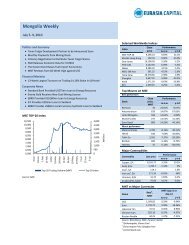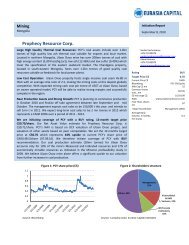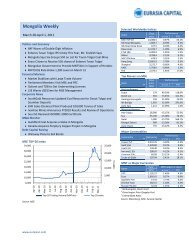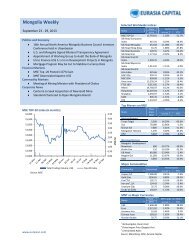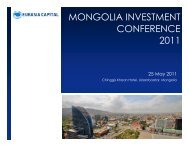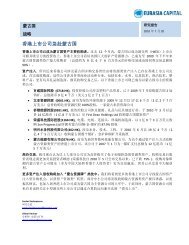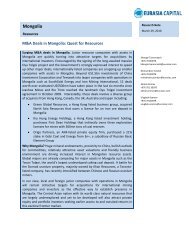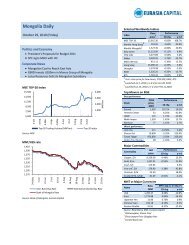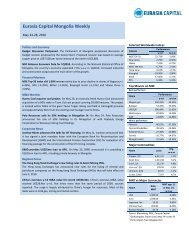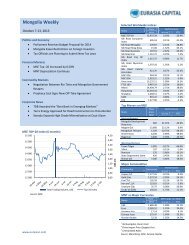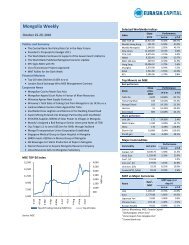Battle For Khan Mongolia - Eurasia Capital
Battle For Khan Mongolia - Eurasia Capital
Battle For Khan Mongolia - Eurasia Capital
Create successful ePaper yourself
Turn your PDF publications into a flip-book with our unique Google optimized e-Paper software.
<strong>Mongolia</strong>Resources<strong>Battle</strong> <strong>For</strong> <strong>Khan</strong>Russian and Chinese state companies are competing in quest for uranium resources in<strong>Mongolia</strong>. <strong>Mongolia</strong>’s two superpower neighbours, Russia and China, are eyeing hugeuranium resources in the Central Asian nation to meet growing demand and maintaingeopolitical supremacy. Russia, the world’s fifth largest uranium producer and holder of theworld’s third largest uranium reserves, signed an agreement in May last year with <strong>Mongolia</strong>on establishing a joint venture to develop <strong>Mongolia</strong>’s uranium deposits. Almost in half yeartime in December 2009, Russia’s state-owned AtomRedMetZoloto (ARMZ), the world’s fifthlargest uranium producing company, made a hostile bid to acquire <strong>Khan</strong> Resources, aCanadian company that holds a 58% stake in the Dornod property, the largest uraniumdeposit in <strong>Mongolia</strong>. Along with Russian, Chinese companies have also expanded theirforeign resource acquisitions to uranium miners in <strong>Mongolia</strong>. CNNC, China’s state-ownedcompany, acquired a 69% stake in Western Prospector, a Toronto-listed uraniumexploration company with assets in <strong>Mongolia</strong>, for US$25mn on June last year. And theChinese nuclear company has bid for <strong>Khan</strong> Resources, the same target for Russian ARMZ.<strong>Khan</strong> Resources – a battle between ARMZ and CNNC. <strong>Khan</strong> entered into a Memorandumof Understanding with the <strong>Mongolia</strong>n Government on January 14 2010, in response toARMZ’s bid, which <strong>Khan</strong> believes as “an opportunistic and inadequate offer”. The new nonbindingmemorandum suggests that MonAtom, the state-owned company, will acquire a51% in each majority <strong>Khan</strong>-owned Central Asia Uranium Company (CAUC) and <strong>Khan</strong><strong>Mongolia</strong> in accordance with the Nuclear Energy Law. Along with ARMZ, CNNC agreed on 1February 2010 to acquire all of <strong>Khan</strong>’ outstanding common shares for cash consideration ofC$0.96 per share, a 48% premium to ARMZ’s bid price. <strong>Khan</strong>’s management recommendedshareholders accepting CNNC’s offer that comes with more favorable conditions than thoseof ARMZ.In our view the winner of the battle for <strong>Khan</strong> Resources is more likely to be a political choicerather than commercial. We would not be surprised if, among other options, ARMZ comesup with even better offer or the Russian government proposes better political dividend tothe <strong>Mongolia</strong>n policy makers. Whichever scenario plays out, the decisive action at the endon the prospect of the Dornod project may be taken by the <strong>Mongolia</strong>n government.Research NoteFebruary 19, 2010Akmal Aminov+976 701 30078akmal.aminov@eurasiac.comUlugbek Azamov+976 701 30078ulugbek.azamov@eurasiac.com<strong>Khan</strong> Resources’ Share Performance C$21.81.61.41.210.80.60.40.20CAUC Shareholder StructureMonAtom21%Russia'sARMZsubsidiary21%<strong>Khan</strong>Resources58%Jan-08Mar-08May-08Jul-08Sep-08Nov-08Jan-09Mar-09May-09Jul-09Sep-09Nov-09Jan-10Source: BloombergSource: <strong>Khan</strong> Resources
<strong>Battle</strong> <strong>For</strong> <strong>Khan</strong><strong>Mongolia</strong> gets control over its uraniumThe <strong>Mongolia</strong>n Government has been longcontemplating on adopting a new nuclear law throughwhich it could get a bigger stake and firmer grip onuranium deposits located in the country. In January2006, the <strong>Mongolia</strong>n Government identified 49strategically important mineral deposits, which includedsuch uranium sites as Mardai, Dornod and Gurvanbulag,all located in Dornod aimag. In July 2009, laws onnuclear energy and radioactive minerals were passedalong with establishment of government bodies toundertake uranium exploration and mining on behalf ofthe state. According to the new Nuclear Energy Law, thestate will own without any payments at least 34-51% ofuranium assets in <strong>Mongolia</strong> depending on whether theexploration work was done using state funding. This haddirect implication for <strong>Khan</strong> Resources and as a result theDornod mining license was suspended in July 2009.Main Dornod (“Dornod”) is known as the largesturanium deposit in <strong>Mongolia</strong> with indicated and inferred resources of about 29.2thousand tonnes and probable reserves of 24 thousand tonnes. The problemsthat <strong>Khan</strong> Resources had with its license and operation (suspension, hostiletakeover bid by ARMZ) are direct consequences of the fact that Dornod issignificant uranium project that attracts attention from global major uraniumcompanies and the <strong>Mongolia</strong>n Government itself, since uranium is not just acommodity that offers investment return - it is a metal, whose production & saleis highly regulated.ARMZ’s Hostile BidUranium reserves by country, 2008AustraliaKazakhstanRussiaSouth AfricaCanadaUSABrazilNamibiaNigerUkraineJordanUzbekistanIndiaChina<strong>Mongolia</strong>During Russian Prime Minister Vladimir Putin’s visit to <strong>Mongolia</strong> in May 2009,two countries signed an agreement on establishing a joint venture to develop<strong>Mongolia</strong>'s uranium deposits. The agreement envisaged setting up “DornodUranium” Limited-Liability Joint Company by Atomic Energy Department of<strong>Mongolia</strong> and “Rosatom”, Russia’s state-owned atomic energy corporation.The Dornod project is not new to Russia, as a Russian geological expedition ledthe start of open pit mining at the Dornod deposit in 1988. Uranium ore wasextracted by a subsidiary of Priargunsky Mining & Chemical Enterprise (owned byARMZ) from 1988 to 1995. But all the operations on the site were placed onstand-by and no further mining has occurred since 1995.In July 2009, <strong>Khan</strong> Resources announced that its Dornod license to CAUC wassuspended based on alleged failure to register the deposit reserves with StateIntegrated Registry for approval by the Minerals Council. Suspension of thelicense brought suspicions of undue Russian influence on <strong>Mongolia</strong>. Suspicionwas fuelled further after ARMZ, the world’s fifth-largest uranium producer and asubsidiary of the Russian state-owned nuclear energy corporation Rosatom,made a takeover bid of C$35.1mn to <strong>Khan</strong> Resources. The board of <strong>Khan</strong>Resources recommended its shareholders to reject the offer, claiming that ARMZ62Research NoteFebruary 19, 20100 200 400 600 800 1,000 1,200 1,400thousand tonnesSource: WNA,NEA and IAEA. * untested reserves may raise theestimate to 1.39 mn tonnes2
<strong>Battle</strong> <strong>For</strong> <strong>Khan</strong>is seeking to take advantage of vulnerable time, and trying to capitalize on theregulatory uncertainty. ARMZ claimed that offer represented fair value andconsiders the economics of the project and the significant political and licensingrisks inherent in its development.Research NoteFebruary 19, 2010CNNC battles over <strong>Khan</strong>On 14 January, 2010 <strong>Khan</strong> Resources has reached a successful settlement withthe Mineral Resources Authority of <strong>Mongolia</strong> whereby the suspension of CAUC’smining license has been terminated. Later <strong>Khan</strong> Resources signed a nonbindingMemorandum of Understanding (MoU) with <strong>Mongolia</strong>’s State-owned MonAtomon setting up a joint venture company to own and develop the Dornod project.According to <strong>Khan</strong>, the MoU should lead to the Dornod uranium developmentgoing ahead with the state involvement while still protecting the interests of<strong>Khan</strong>’s shareholders. As a result of transactions, <strong>Khan</strong> Resources will own 65% ofa new joint venture company with MonAtom. Joint venture will own 74% ofCAUC and 100% of <strong>Khan</strong> <strong>Mongolia</strong>, implying that <strong>Khan</strong> Resources will own only48% of license-holding CAUC, while <strong>Khan</strong> <strong>Mongolia</strong> will hold no licenses andsimply operate future mines.<strong>Khan</strong>’s objective in entering into MoU was to protect the company in light of thehostile bid by ARMZ and has proved to be a successful accomplishment. On 1February 2010, <strong>Khan</strong> Resources announced that it entered into an agreementwith CNNC Overseas Uranium Holding Ltd, a subsidiary of China National NuclearCorporation (CNNC), pursuant to which CNNC agreed to acquire all of <strong>Khan</strong>Resources’ outstanding common shares for cash consideration of C$0.96 pershare. The offer represented 118% to the closing price prior ARMZ bid and a 48%premium to the ARMZ’s offer price. The CNNC bid was described by <strong>Khan</strong>Resources as "far superior" to the ARMZ offer. The company recommended thatshareholders accept CNNC’s bid that comes with fewer conditions as opposed toARMZ’s.“<strong>Khan</strong>” between Russia and ChinaThis development adds another dimension to complicated relations betweenpartners in CAUC. Both China and Russia are eager to have access to the Dornoduranium deposit. In this battle, the <strong>Mongolia</strong>n Government may hold the finalword. The need for arbiter for the bidding war between the two uranium majorswas highlighted by an ARMZ’s statement on the CNNC’s bid. The Russiancompany questioned the legality of the MoU on the Dornod licensing andownership signed by <strong>Khan</strong> and MonAtom. ARMZ claims that the MoU violatesthe <strong>Mongolia</strong>n state policies on radioactive mineral resources and nuclearenergy, nuclear energy law as well as the <strong>Mongolia</strong>n government’s obligationsunder the <strong>Mongolia</strong>n-Russian Inter-Governmental Treaty signed in August 2009,which suggests establishing a Russian-<strong>Mongolia</strong>n joint venture to develop theDornod property.<strong>Khan</strong> Resources is not the first <strong>Mongolia</strong>-based uranium company that interestedCNNC. On June 2009, CNNC subsidiary acquired a 69% stake in WesternProspector Group Ltd, a Toronto-listed uranium exploration company with assetsin <strong>Mongolia</strong>, for US$25mn. Although all uranium exploration licenses of Western3
<strong>Battle</strong> <strong>For</strong> <strong>Khan</strong>Prospector are now suspended, soon it will likely be renegotiated taking intoaccount changes in the legislation. As stipulated in the nuclear energy laws, the<strong>Mongolia</strong>n government will own at least 51% in the Gurvanbulag deposit ofWestern Prospector.China’s own uranium resources can meet domestic demand until 2020, estimatessuggest, mostly due to the Ordos Basin of Inner <strong>Mongolia</strong>. But according to ChinaInstitute of Atomic Energy, the world’s second-largest energy consumer wants toincrease the use of nuclear power by about 10 times by 2030.Russia that holds the world’s third largest uranium reserves and is the world’sfifth largest uranium producer is positioning itself as a major player in the nuclearpower industry. The Russian Government has made its priority to increase theshare of nuclear power in its total energy production. Currently, its nuclearpower plants produce 16% of total energy in the country. By 2030, Russia’s aimsto control 45% of the world’s uranium enrichment market and 20-25% of theworld’s nuclear plant construction market.The agreement between <strong>Mongolia</strong> and Russia on establishing “Dornod Uranium”joint venture was not the only deal that was signed during the Russian PrimeMinister’s visit in May 2009. Both countries agreed to sign deals worth US$6.5-7bn, which would improve <strong>Mongolia</strong>’s railway and road infrastructure, andsupport construction of small- and medium-sized nuclear-power plants.<strong>Mongolia</strong> wants not only to be a producer and seller of its natural resources, butalso to build reprocessing industries with revenues from the mining industry.Seemingly, Russia has pledged to support construction of nuclear power plants in<strong>Mongolia</strong>.In our view the winner of the battle for <strong>Khan</strong> Resources is more likely to be apolitical choice rather than commercial. We would not be surprised if, amongother options, CNNC and AMRZ keep offering higher prices and favourable termsuntil the <strong>Khan</strong> shareholders accept the most attractive ones. However, whicheverbidder wins the Canadian junior, the decisive action on the prospect of theDornod project is likely to be taken by the <strong>Mongolia</strong>n government.Research NoteFebruary 19, 2010Dornod Property: Brief ProfileThe Dornod Property is located in northeastern <strong>Mongolia</strong>, approximately 125kmnorth of Choibalsan, capital of the Dornod Aimag (province). Choibalsan issituated along a major east-west road connecting the town with Ulaanbaatar,some 650km to the west.Uranium mineralization in the Dornod property is found at the depths of 30meters to 700 meters and is concentrated within a 30km 2 area. Thirteen depositshave been identified in the property, of which five have been relatively wellexplored.The detailed mineral reserves and resources have been estimated for thedeposits No. 7 and No.24
<strong>Battle</strong> <strong>For</strong> <strong>Khan</strong>Research NoteFebruary 19, 2010The deposit No. 7, which is the largest, has beenDornod Uranium Projectpartially developed by two shafts and around 20,000meters of development drifts.The deposit No. 2 is an open-pit mine. The RussianGeological Expedition led the start of open-pit miningat the deposit in 1988. Uranium ore was extracted byErdes Mining Enterprise, a subsidiary of PriargunskyMining & Chemical Enterprise from 1988 to 1995.Until 1995, 590,000 tonnes of ore at an averagegrade of 0.118% U 3 O 8 was extracted and transportedthrough a 550km rail to a uranium processing facilitySource: Company dataat Krasnokamensk in Russia. But all the operations onthe site were placed on stand-by and no further mining has occurredsince 1995.Mineral Reserve EstimateDeposit Category Uranium ore(mn tonnes)Grading,% U 3O 8lbsU 3O 8(mn)U 3O 8(‘000tonnes)No. 7 Probable 10.63 0.174 40.8 18.52No. 2 Probable 7.41 0.074 12.1 5.49Total Probable 18.04 0.133 52.9 24.01Source: Company dataMineral Resource EstimateDeposit Category Uranium ore(mn tonnes)Grading,% U 3O 8lbsU 3O 8(mn)U 3O 8(‘000tonnes)No. 7 Indicated 14.36 0.154 48.6 22.06No. 2 Indicated 10.95 0.065 15.7 7.12Total Indicated 25.31 0.116 64.3 29.19No. 2 Inferred 2.18 0.050 2.4 1.09Source: Company dataThe Dornod Property consists of two mineral licenses, a Mining Licence (237A)and an Exploration Licence (9282X). <strong>Khan</strong> wholly acquired CAUC HoldingCompany Ltd. in 2003 (then known as World Wide <strong>Mongolia</strong> Mining Inc.), aBritish Virgin Islands company.According to a definitive feasibility study of <strong>Khan</strong>Resources, per lb cost of U 3 O 8 produced from theDornod deposit in <strong>Mongolia</strong> could be aroundUS$23.22 (US$51.15 per kg) or US$58.26 pertonne of ore. The study assumes a throughput of3,500 tonnes per day over a 15-year mine life,which will generate an average annual productionrate of 3mn lbs U 3 O 8 (1,362 tonnes), almost 3% ofglobal uranium demand. The initial capital cost ofthe project is estimated to be approximatelyUS$332.79mn.Major Uranium deposits of <strong>Mongolia</strong>DepositOwnerDornod <strong>Khan</strong> Resources (58%),<strong>Mongolia</strong> (21%), Russia (21%)Resource(‘000 tonnes)29.12Gurvanbulag CNNC (69%) 10.1Khairkhan Denison Mines (70%),<strong>Mongolia</strong> (15%), Russia (15%)Kharaat Denison Mines (70%),<strong>Mongolia</strong> (15%), Russia (15%)Source: Company data, <strong>Eurasia</strong> <strong>Capital</strong> estimates4.42.55
<strong>Battle</strong> <strong>For</strong> <strong>Khan</strong>ContactsResearch NoteFebruary 19, 2010Alisher Ali Djumanov CEO alisher.djumanov@eurasiac.comOyunbold GomboExecutive Director,oyunbold.gombo@eurasiac.com<strong>Eurasia</strong> <strong>Capital</strong> <strong>Mongolia</strong>Investment BankingMarat Utegenov Director marat.utegenov@eurasiac.comBekzod Kasimov Associate Director bekzod.kasimov@eurasiac.comTurbat Munkhsuren Analyst turbat.munkhsuren@eurasiac.com<strong>Khan</strong>gai Tserenraash Analyst khangai.tserenraash@eurasiac.comResearchSardor Koshnazarov Head of Research, Oil & Gas sardor.koshnazarov@eurasiac.comDosbergen Musaev Analyst, Strategy dosbergen.musaev@eurasiac.comUlugbek AzamovAnalyst, Infrastructure,ulugbek.azamov@eurasiac.comPropertyAkmal Aminov Analyst, Metals & Mining akmal.aminov@eurasiac.comBatbayar Bat-Erdene Analyst, Metals & Mining batbayar.bat-erdene@eurasiac.comRentsendorj Yondon Analyst, <strong>Mongolia</strong> Equities rentsendorj.yondon@eurasiac.comZultsetseg Chuluunbat Analyst, <strong>Mongolia</strong> zultsetseg.chunluunbat@eurasiac.comBahadir Uskenbaev Analyst, Kazakhstan bahadir.uskenbaev@eurasiac.comSales and TradingDima Orazimbetov Director dima.orazimbetov@eurasiac.comZhyldyz Sadyralieva Associate zhyldyz.sadyralieva@eurasiac.comSherzod Rakhimov Analyst sherzod.rakhimov@eurasiac.comBolor Ulziisaikhan Broker bolor.ulziisaikhan@eurasiac.comEnkhbayar Davaatseren Trader enkhbayar.davaatseren@eurasiac.comAddresses:HONG KONG33/F One International Finance Centre1 Harbour View Street, Central,Hong KongTel.:+852 2824 8716Fax: +852 2166 8999MONGOLIASuite 71, 7 th Floor, Grand Office CenterJamiyangun Street 12, 1 st Khoroo,UlaanbaatarTel: +976 7013 0078Fax: +976 7013 0078UZBEKISTAN11A, Almazar StreetTashkent 100003Tel: +998 71 1403538Fax: +998 71 1403533CHINA11 th Floor, North Tower, Beijing Kerry CentreNo.1 Guang Hua Road, Chao Yang District,Beijing 100020,Tel.: +86 (0) 10 6599 7912Fax: +86 (0) 10 6599 9100KAZAKHSTANNurly Tau Business CenterBuilding 2B, office 505, 5 th Floor13 Al-Farabi AvenueAlmaty, 050059Tel: + 727 3111080RUSSIAMoscow Enbankment TowerBlock C, 18 Krasnopresnenskaya NaberezhnayaMoscow 123317Tel: +7 495 967 7676Fax: +7 495 967 7600©2009 <strong>Eurasia</strong> <strong>Capital</strong> Ltd. All rights reserved.DISCLAIMERThis report is made for information purposes only, and does not constitute an offer, solicitation of an offer to purchase, hold, sell, invest or make any other financial decision. In makingdecisions, investors may rely on their own examinations of the parties and risks involved. Information contained in this report is obtained from the sources believed to be accurate andreliable. Because of the possibility of human or mechanical error as well as other factors such information provided 'as is" without warranty of any kind and <strong>Eurasia</strong> <strong>Capital</strong> Ltd., inparticular, make no representation or warranty, express or implied, as to accuracy, timeliness, completeness, merchantability or fitness for any particular purpose of any suchinformation. Under no circumstances, <strong>Eurasia</strong> <strong>Capital</strong> Ltd. have any liability to any person or entity (-ies) for (a) any loss or damage in whole or in part caused by, resulting from, orrelating to, any error (negligible or otherwise) or other circumstances or contingency within or outside the control of any of their directors, managements, officers, employees, oragents in connection with compilation, analysis, interpretation, communication, publication or delivery of any such information, or (b) any direct, indirect, special, consequential,compensatory or incidental damages whatsoever (including without limitation, loss profits) even if <strong>Eurasia</strong> <strong>Capital</strong> Ltd. is advised in advance of the possibility of such damages, resultingfrom the use of or inability to use, any such information.6



